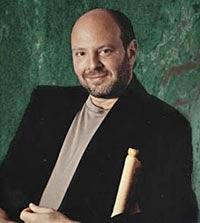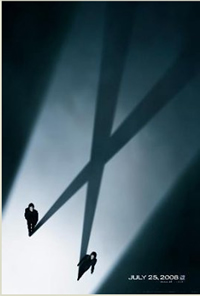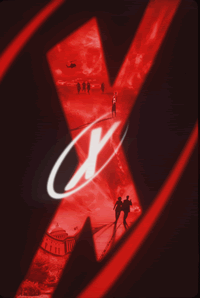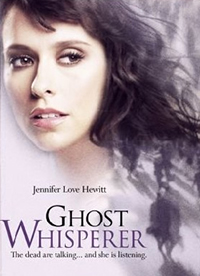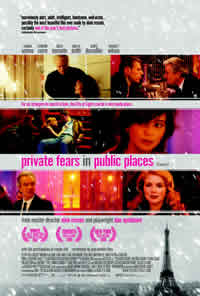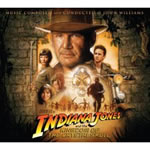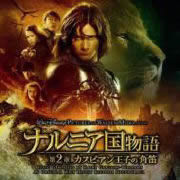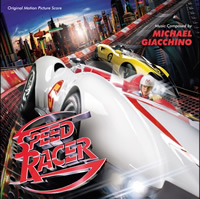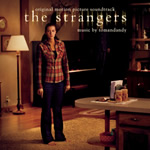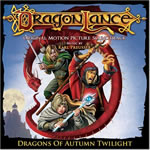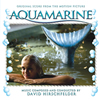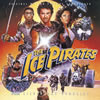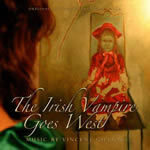 |
Soundtrax: Episode 2008-11
May 23, 2008
By Randall D. LarsonX-Files Revisited
This week we talk with Mark Snow about his music for the new X-Files movie and get a small glimpse at what a massive score this is going to be. He also discusses scoring The Ghost Whisperer and his sublime score for legendary French director Alain Resnais’s Private Fears in Public Places. We kick of the Summer with reviews of the soundtracks for Indiana Jones and the Kingdom of the Crystal Skull, The Chronicles of Narnia: Prince Caspian, Speed Racer, The Strangers, and Dragonlance: Dragons of Autumn Twilight, fine scores all. And, as usual, the latest film music news is gathered from the seven seas.
Mark Snow Interview: Mark Snow on X-Files: I Want To Believe
Mark Snow is best known for his many seasons of music scoring for TV’s The X-Files and Millennium, although his work has encompassed many more series (including the popular shows Smallville and The Ghost Whisperer) and made-for-television movies as well as a handful of feature films (including the recent Award winning drama from legendary French director Alain Resnais, Private Fears in for Public Places, aka Coeurs (Hearts) – quite a significant coup for an American television composer, and one that earned him a César Award nomination [the main national film award in France] for best score. Snow’s many musical scores for American television and films have also garnered him numerous Emmy nominations and ASCAP awards. In 2006, he became the first composer to receive ASCAP's prestigious Golden Note Award for lifetime achievement and impact on music culture. Mark Snow's iconic X-Files theme remains a worldwide phenomenon.
Snow is now poised to regain that recognition as the new X-Files movie, The X-Files: I Want To Believe, preps for release on July 25th. Snow scored the show’s first feature film, The X-Files: Fight the Future (1998), with a massive orchestral score that took the show’s central thematic material and expanded it to fit the sonic scope of the big screen, and his music for the new film promises to raise the bar even higher. Interviewed last week while in the midst of completing the new score, Mark Snow describes his music for the further adventures of agents Mulder and Scully, along with his other recent work.
Q: So how far along are you with the new X-Files movie?
Mark Snow: Half way done.
Q: What can you tell me about this score?
Mark Snow: We’re using a gigantic orchestra with no trumpets or high woodwinds. It’s tons of brass, big strings, and a few low bass clarinets, contrabassoon. Plus we have another orchestra doing effects stuff on top of it – no music, just musical effects like [imitates an orchestral effect] “haaiii-pnnnnnn…”, that lay in at certain points. I’ve also got a genius sample percussion guy who’s adding on to that, plus my own atmospheric stuff there, so the music is made up of these four elements. I’ve been lucky enough to get Alan Meyerson as the music mixer – he’s the engineer who does Hans Zimmer’s stuff and who is a technical genius. He is probably one of the few guys who can pull this off. We’ve got assistants among assistants – he’s got his crew, I’ve got a couple of guys just helping me, sending MIDI files, getting these things out to the copyist.
Q: The first X-Files movie expanded the music you were doing the TV series and gave it a huge widescreen scope. It sounds like this new score will be doing that yet again, intensifying what you had in the first X-Files movie by yet another several degrees.
Mark Snow: But it’s very different. This movie is not along the lines of the mythology story of The X-Files, with the government conspiracy and aliens and flying saucers. We’re all sworn to secrecy and death if we talk about the story, but I can tell you that there aren’t any aliens in this movie. It’s much more of a standalone episode, and so the music is not like the last one. Actually there is one cue from the first movie that the music editor tracked in, and it worked great, but that’s it.
Q: Will there be recognizable material such as The X-Files theme, beyond the opening title?
Mark Snow: Yeah. If you’re a musician you’ll hear that in the orchestra parts from time to time. Not blatant, but nice and subtle.
Q: What’s central to the score, musically? Where does the score hang its hat on?
Mark Snow: It’s just dark. Deep and pulsating. On the other hand there are two really beautiful melodic themes. One is sort of like the Gabriel Fauré Requiem, that kind of thing. I am using boy soprano live, and then a counter tenor, which is a male voice that sounds like a woman’s.
Q: How much music is this score going to take?
Mark Snow: Tons! Maybe 70 minutes.
Q: What was it like revisiting, or returning to The X-Files after several years hiatus?
Mark Snow: Like fitting into a great pair of old shoes.
Q: Any plans yet for a soundtrack album?
Mark Snow: Yes, on the Decca label.
Q: Meanwhile, you’re still doing Smallville and The Ghost Whisperer…?
Mark Snow: The seasons have both ended, so I’m not doing either of them right now. I won’t be coming back on Smallville, it’s just been way too much. I will come back next season to do Ghost Whisperer.
Q: You worked on Smallville for seven seasons. How has the music or its needs changed, evolved, or developed throughout that run?
Mark Snow: Not a bit! It was: ‘Pilot: John Williams.’ ‘Yes sir. Done!’ ‘Thanks, bye!’
Q: So it was more maintaining the heroic concept and the mythology than progressing through specific changes…
Mark Snow: That’s right, exactly.
Q: I’ve been enjoying your music for The Ghost Whisperer, a neat mixture of ghosts and character drama with very good writing, excellent performances, and of course a compelling musical underscore.
Mark Snow: The thing that they really want in the music is a real emotional quality. So that’s been a combination of spooky, emotional, and mysterious.
Q: Even though it comes from a supernatural basis and certainly has moments that are spooky/scary but in essence it’s more of an emotional drama.
Mark Snow: That’s right. The idea of people crossing over – they try to do this in a hip way so it’s, in a sense, like Highway To Heaven or Touched By An Angel but much more modern/contemporary/cooler.
Q: When you’re scoring a weekly series like Ghost Whisperer, you’ve defined your musical approach in the pilot. Have there been opportunities in the individual stories of Ghost Whisperer to do something varied, or are you tied to a given musical concept from the start?
Mark Snow: Ninety percent of the music on Ghost Whisperer is under dialog. It’s very rare that there’s music without dialog, for whatever reason. But it’s like setting up a sound and the pallet for it and just revisiting it in different variations. They love the piano, and they love pads and percussion pulsing along, but then all of a sudden if you do an orchestra sound with a real strong melody they just go nuts for that. It’s the contrast, that what I think is successful about that.
Q: Are there’s enough variation in the storylines to afford different instrumental pallets?
Mark Snow: Certainly, when the show calls for some ethnic music or we go to different locations. Sometimes these flashbacks have period piece connotations to them also, which calls for different kinds of music.
Q: Was there a specific way that they asked you to deal with the supernatural aspects, like the appearance of the ghosts, or emphasize when things are going a little bit strange?
Mark Snow: They rely heavily on sound effects for all those things, when the ghost pops in or pops out or moves across the room. I kind of lay low then, because the sound effects guys really go to town there. At first they wanted us both to go crazy at those moments and they’d pick out what they liked the best, but that turned out to be a mess, so then I knew to calm down and let the sound effects do those moments. But obviously sound effects can’t do the nice melody stuff, so I get my turn.
Q: You recently composed the music for Alain Resnais’ Coeurs (Private Fears in Public Places), which must have been quite a coup to get to work for the legendary French director. I understand that Resnais was attracted to your music due to the X-Files. How did he first get in contact with you for this?
Mark Snow: He just called. He found out who represented me and called. I never associated his name with all his marvelous past, which is classic, this guy is a giant in the French New Wave cinema. He just heard X-Files reruns on French TV, and he thought the music would be perfect, for whatever reason.
Q: He was drawn to the more melodic material which is laced throughout the X-Files scores, rather than the scary stuff?
Mark Snow: Actually, no! He was really talking about the more atmospheric music. He thought that would be fitting. They had tracked it with my music. There was some melodic stuff but nothing like what it turned out to be, that’s for sure.
Q: Did you score it over here or did you go over to France?
Mark Snow: I met with him in Paris but I actually did it in Connecticut. I have a studio out there.
Q: What was the process, as far as determining what he wanted and how you should approach the music?
Mark Snow: He said, ‘just do what you think is right, like the kind of thing we put in [the temp score].’ I had actually written a theme before I got there, just from reading the script, and it turned out to be the main theme. I sent him music from Connecticut, and then it was waiting for that first phone call, that initial reaction, which is always nerve racking. But he called and said ‘it’s great,’ and then as I kept sending him stuff, he would just say, ‘oh, make this part a little this, or a little that.’ ‘Okay, fine.’ ‘Wonderful, thank you!’ And done. Then what happens, in France, apparently, they take the music and they just put it wherever they want to! So there were places where they moved the starts and they fade it in early or used another cue, stuff like that. I mean, not that you’d really notice, and nothing that was like bad from my point of view. Then they called and said ‘you’ve got a Cesar nomination along with a lot of other people in the group here.’ It was a big hit at all these festivals, and it won the Special Award at one of them. And now there’s a possibility of doing his next movie, which he’s just finishing now.
Q: How did this feature film experience differ from writing for a television series?
MS: The marvelous thing about movies as opposed to TV, you can write these kinds of things. In TV the producers are always going, ‘no, no! Pulse! Pulse! We need rhythm! We need to keep the audience awake!’ And then if you write a minor chord, they go, ‘no, no! That’s sad! We can’t have sad!’ Even if it is sad! But with this, you get that mood going, you get your theme going, and that’s it. That’s what was so great.
Q: What was the element that you felt was the crux of the film – or “this is what I want to hang my score on?”
Mark Snow: That’s a good question. I would say, toward the end, you start feeling, as corny as it sounds, the tragic element of these people not being able to connect. So it was toward the end when you knew it was like, oh shit, it was inevitable that this ain’t going to work out for anyone. That’s where the meat of the score lay.
Q: You recorded in Connecticut?
Mark Snow: I have a studio there. I played it and recorded it – it was all by me, there was not one live instrument. But we mixed it at the Sony Records studio in New York. I had my mixer fly in from L.A., and we did it, which was amazing. It was pretty great.
Q: So what’s coming up for you after the new X-Files movie?
Mark Snow: I’ve got this other movie coming up, a kids’ movie called The Knights Of Appletown. It was directed and written by Bobby Moresco, who co-wrote Crash with Paul Haggis, of all things. It’s a sweet little movie and it’s miles and miles away from X-Files!
New Soundtrax in Review
This week’s big release is surely the eager anticipated soundtrack to Indiana Jones and the Kingdom of the Crystal Skull, proffering John Williams’ return to the fantasy-adventure franchise in which he redefined swashbuckling heroic adventure filmscoring, just as he redefined swashbuckling heroic science fiction filmscoring with Star Wars not long before. Released by Concord, the new IJ soundtrack is everything you’d want in a Williams score, and everything you’d want in an Indiana Jones score – a rousing and thoroughgoingly symphonic action composition with moments of passion and poignancy, and plenty of amazing orchestral daring do. In between the familiar “Raiders March” and “Finale” with their familiar reprisal of themes from the first three scores, we are introduced to a variety of new material for new characters, new locales, and new situations. Crystal Skull is far more than a rehash of what’s gone before, it’s an affectionate extension of the Indiana Jones musical legacy into new territories and with a fresh perspective. The old, familiar motifs have come along, but, like the wizened and gray haired Dr. Jones himself, they are aging gracefully and fit well into the new environment of the fourth film, which takes place in 1957, 19 years after the events of the Last Crusade (and the same number of years since that film came out in 1989). The music, while capturing very similar flavors to that of the first three films, retains a slightly more advanced sensibility – perhaps evoking the slightly less innocent late 50s as opposed to the simpler 1940s of the Greatest Generation, of which Indiana is now an aging member with a youthful protégé along to remind him of it. “Call of the Crystal,” the first new track after the familiar “Raiders March” is something right out of Miklós Rózsa film noir, a pleasing and mutedly exciting atmosphere from strings, horns, and winds that perfectly sets the tone for this new adventure. “The Adventures of Mutt” is a dazzling scherzo for strings – this score’s equivalent to “Promenade (Tourists on the Menu).” The Indiana Jones theme emerges from horns out of the light classical violin bowing, and we’re in theme-and-action territory as Williams hurls the motif into the midst of an orchestra, which catches it and tosses it to and fro amid the energetic figures and passages as we are introduced to Mutt (Shia LaBeouf), son of Indy’s lost again lover, Marion (Karen Allen). “Irina’s Theme,” another of the score’s new motifs, warming up Cate Blanchet’s cold war Soviet troublemaker; the theme shares much in its melody and harmony with Marion’s Theme from Raiders of the Lost Ark; the dual themes are bookends, images of one another, with Indiana’s theme pressed closely between them. Williams’ classic “The Throne Room: Dawn” theme from the first Indie movie makes a brief and welcome reappearance in “The Spell of The Skull,” which also nicely revisits several of the other themes as it progresses into a boiling orchestral climax. There’s a fun Latin and South American motif in the middle of “The Journey to Akator,” alluding to the sequences in Mexico and Peru. Williams used layered strings playing against and amidst his woodwinds to great foreboding affect in tracks like “Orellana’s Cradle” and “Oxley’s Dilemma,” a pair of good suspensers, brooding and mysterious, the latter building to a slowly surging climax. Williams’ (and Indie’s) predilection for wildlife is evident in a trio of action cues: “The Snake Pit,” “Secret Doors and Scorpions,” “Ants!” – each of which quiver with rapid movement that may make listeners involuntarily brush their shoulders. The former takes on the classical sensibility of “Adventures of Mutt” and its “Promenade” qualities – very crisp and uppercrust material for violins punctuated by restrained brass and woodwinds, a splendid counterpoint against the image of a pit full of Indie’s hated vipers; whereas “Secret Doors and Scorpions” scuttles across the musical floor from a languid interpretation of the Main Theme through a stone-cold mysterioso into a series of incredibly frenzied orchestral dissonances – flurries of strings, percussive ratches and raps, shrieking horns – as doors are opened and stinging arachnids emerge in force. The latter through punches of brass and tympani and swirling cyclonic violin patterns achieves its own sense of panic. “Jungle Chase” is a terrific action track propelled along at high speed – every resource of the orchestra employing its own form of melodic aggression in a controlled musical mêlée.
It’s been said that the first four tracks of the Indiana Jones and the Kingdom of the Crystal Skull album are concert arrangements of the score’s primary themes rather than direct soundtrack cues, which seems to be true; after introducing his thematic material in a fairly straightforward manner in this opening quartet of tracks, the action cues pretty much take over until the Finale; but the action material exhibits Williams’ at his finest – very much in control of the orchestra, lacing his themes through and around the frantic action surges and moody mysteriosos. The score reportedly makes use of a Continuum Fingerboard, an electronic piano keyboard that uses sensors to detect every motion of the player's fingers. In addition to pushing down notes, the player can slide his or her fingers across the instrument, which gives the keyboard a sonic range and sound similar to that of a woodwind instrument. The instrument, invented in the early 2000s, has been used to generate sound effects in Superman Returns and in Spielberg’s War of the Worlds, but Williams is using it musically to generate a very unusual timbre within his orchestral renderings. Listen for it at the end of “Irina’s Theme,” “Oxley’s Dilemma,” and elsewhere.
It’s pointless to cite endless minutiae, as some are prone to do, of which cue was or wasn’t included on the album, which theme was emphasized on the album more than it really was in the movie (or vice versa). This kind of myopia is counterproductive and disrespectful to the integrity of the musical presentation at hand. The bottom line is that this is a fine score and the album is thoroughly satisfying, musically.
For more interpretations of the score, see the John Williams Fan Network at: http://www.jwfan.com/index.php?option=com_content&task=view&id=997&Itemid=1
Harry Gregson-Williams’ score for the second Chronicles of Narnia film, Prince Caspian, starts out quite aggressively with a detonation of very active, energetic strings and percussion. Like the World War I prelude to The Lion, The Witch, and the Wardrobe, this allows the score to start out with a sonic bang. Gregson-Williams has provided a massive score for this second adaptation of the beloved C.S. Lewis fantasy series, and Disney, which released the score on CD last week, has done a splendid job capturing the score on CD, which retains an outstanding sound dynamic with thundering low end, physically-felt percussion, and a rich depth of sonic resolution. The score retains the thematic structure of the first score, as “The Kings and Queens of Old” returns us to Narnia, land of fauns and witches, with its elegant and crystalline theme softly resplendent from horns and choir. “Arrival at Aslan’s How” reprises the melodic Aslan theme from the first film, beautifully capturing its tawny nuances of heroism, sacrifice, honor, and majesty through horns, strings, and choir. The score’s powerful main theme makes its presence known throughout the score, especially in “Battle At Aslan’s How,” a massive and melodic battle scene, culminating in a magnificent rendering of the Aslan theme. “The Duel” is a highly dramatic action scene, dappled with thematic phrasings and melodic strains in the midst of the battle music. I haven’t seen the film yet but some comments I’ve read have indicated some of Gregson-Williams’ new themes haven’t been included on the album in favor of more of the energetic, melody-based action and battle music. That be as it may, the score as represented here is full-blooded and very likeable. It’s a darker score than its predecessor, since the film itself comprises a darker period of Narnia history, and the pervasive use of choir gives it an edge that seems both epic and tragic; with the Aslan and Narnia themes rising in contrast heavenward with a rich sonority of French horn and violins. The film’s more complicated storyline, which slowly draws a trio of plotlines together into a furious, climactic battle, rather than the somewhat simpler linear story of The Lion, The Witch, and the Wardrobe, supports the use of more complicated music, but even at its most dissonant, the score retains the melodic elegance that is at its heart. New themes for Caspian and his adversaries, the piratical Telmarines, appear but aren’t as immediately appealing as the motifs reprised from the first film, which remain more dominant and far-reaching. The cd provides a dozen score cues of almost an hour’s length (but only about half of the music actually composed for the film) before the inclusion of the obligatory pop songs; one of the four (a plaintive folk song called “Lucy,” about one of the characters, sung by Hanne Hukkelberg) does not appear in the film. Regina Spektor’s “The Call” is an appealing song enhanced by some rich string arrangements that ties it in somewhat with the sound of the score; but the absence of a strong chorus leaves the song slightly lacking to my ears. I found Oren Lavie’s “A Dance ‘Round the Memory Tree” and its morose melody is fairly unappealing, but “This is Home” by Switchfoot is a splendidly attractive quasi-anthemic song that serves as a quite satisfying conclusion to the film.
Michael Giacchino’s music for the Wachowsky’s unique interpretation of Speed Racer is a wondrous musical adventure interpolating elements from the old TV cartoon with the kind of modern, rhythmic material that seems to define contemporary action scoring – with Giacchino’s own manic style elevating it to the n’th degree. Released by Varèse Sarabande and also available on iTunes, the score revs up at the start with the somewhat dreamy female voice that introduces “World’s Best Autopia,” gets into first gear with the same tracks drum-beaten rhythm for strings punctuated by tubular bell, setting the stage for the massive race track that will form the film’s environment. “Thunderhead” kicks past second and blasts right into third and fourth gears with a slight Latin flavoring, emerging as a high-octane action rhythm track, very Schifrinesque. Driving ostinatos appear with regularity throughout the score, which also frequently interpolates themes from the ‘60s TV series. Nobuyoshi Koshibe’s Mach-Go-Go-Go/Go Speed Racer motif from that show is laced throughout Giacchino’s action music. “Go Speed, Go!” is a brief but straightforward and cheer-inducing rendition of the Koshibe theme. The album’s 20 tracks, ranging from just over a minute to more than 6 minutes in length, mostly take the film’s title at heart and race along at a breakneck speed – plenty of orchestral chops to manipulate, control, orchestrate, and drive to the finish line. Speed Racer is an orchestrator’s score – a variety of motifs and themes crafted by Giacchino or recalled from Koshibe and carefully chiseled into the high-octane rush of the action cues in a way that they all make sense and never fall into chaotic dissonance. Rhythm is the music’s mainstay, straight-ahead and jet-speed rhythm, but there are moments of sublime eloquence remaining in the score. The evocative woman’s voice that opened “World’s best Autopia” returns in “Tragic Story of Rex Racer,” recurring to suggest the legacy and loss that Speed feels toward his brother, killed in a race accident when Speed was a child, and whose memory inspires Speed in his quest for racing victory. It recurs in “Casa Cristo,” a cool John Barresque/James Bondesque sexy action cue for trumpets, strings, chorus – that becomes a furious musical action fest for wildly flailing violins, hysterical glissandos from harp, a twanging electric guitar break, ferociously pounding drums and a propulsion of surging brass intoning the Mach-Go-Go-Go motif as a powerful, relentlessly speeding ostinato. The voice also has a brief appearance amidst the furiosity of “The Maltese Ice Cave,” where it heralds the entrance of choir to support and embiggen the host of musical activity of the track. “End of the First Leg” breaks for a nice respite of Herrmannesque chord progression, a mysterious and brooding apprehensivo. “Racing’s In Our Blood” is a poignant moment for introspection in the midst of the challenge. “He Ain’t Heavy” is a softly reflective track for Speed, hushed and tentative strings, with touches of triangle and harp.
“Vroom and Board” (cute title) roars out of a gate of tympani fills to surge forward and then morph into a cute little gait for vibrantly flailing violins that open into Giacchino’s own massive Speed Racer motif, only to shift again, cartoonlike, into a theatrical jazz tune for strings, xylophone, muted trumpets. The cue resembles a Carl Stalling composition in its schizophrenic shifts of style and tone, culminating in a broodingly reflective melody for solo violin over winds. “Bumper to Bumper, Rail to Rail” is a terrific action motif, given a splendid 60’s jazz sensibility, riff-to-riff. Stroking stabs of strings pair off against shouts of trumpet and a congestion of violins that continually amp up the excitement as the cue accelerates into a rocking orchestral rhythm-and-propulsion riff. “World’s Worst Road Rage” opens with monster chords, rage personified through orchestral aggression; then it downshifts into a cool retro jazz rhythm piece, driven on by a strident and purposeful objective of violin strokes. Lots of terrific snare and tom beats and fills propel the cue, slow it down, and accelerate it again; with an electric guitar rhythm finally taking over for the final stretch. “32 Hours” proffers a rollicking action cue embodying slight jazzy undertones and a perpetual rhythm driven by xylophone that really gives the cue a persuasive piston-hammering beat – amidst which both Koshibe motifs resound like a resplendent voiceless Greek chorus. The score’s final two tracks, before the End Credit montage, transform the action material into a triumphant, emotive resolution, the fast-paced rhythms disseminating and crouching below to allow a slow-moving melody for strings and choir to emerge on top: music for victory and achievement. “Let us Drink Milk” opens into a massive cue for full choir and orchestra, powerfully melodic and very anthemic; it’s been about more than winning a race, but about the vindication of Speed’s family legacy. The rhythmic anthem gives way for a reprisal of the “Racing’s In Our Blood” melody, and then the theme rides gently but powerfully on wheels of orchestral and choral rhythm that reaches a crescendo that would be fitting of Handel; and then after a violin break that same mighty orchestra and choral breaks into a marvelous retake of “Mach-Go-Go-Go/Go Speed Racer” that ends the score on a note of elation. The Koshibe redux version of “Speed Racer” then concludes the album in a brilliant morphing of styles, intercutting the theme song from the original Japanese Mach-Go-Go-Go show with the “Go Speed Racer” motif from its American TV incarnation – a fascinating mix of both versions of the theme in one marvelously updated track. The score’s mix of thematic elements, respectful and generous inclusion of material from the film’s original source music, its pleasing fusion of retro with contemporary orchestral and jazz sensibilities, and its overall abundance of satisfyingly ferocious action music tinged with heartfelt poignancy makes Speed Racer a thoroughly outstanding score, and a very nice – if vastly abridged – presentation on CD.
(Check out Rafael Ruiz’s very perceptive review at soundtrack.net for a more detailed analysis of the score: www.soundtrack.net/albums/database/?id=4862&page=review )
(and: Christopher Coleman’s notable review at tracksounds for a great examination of Koshibe’s style for the original show, plus some commentary on the music left off of the Varese album:
www.tracksounds.com/reviews/speed_racer_michael_giacchino.htm )
Lakeshore Records will release tomandandy’s score for the new horror film, The Strangers, on CD on May 27th. It’s available for download on iTunes now. Starring Liv Tyler and Scott Speedman, the film, kind of like the French thriller ils (recently released on DVD as Them), tells of a young couple staying in an isolated vacation home being terrorized by three unknown assailants. The composing duo of tomandandy (Andy Milburn and Thomas Hadju), provide for The Strangers the kind of tension-filled sustained atmosphere they’ve been known for in films like The Mothman Prophecies, The Hills Have Eyes, The Covenant, and P2, punctuated by the prevalent quaking “blasts,” sonic cohesions of disjointed bits of sound that the duo is known for (there some great blasts in “Alone.” Play it loud.). So it’s 45 minutes of ongoing disturbiana, but rather than synths and samples the music is almost entirely orchestral, performed by the Bratislava Symphony Orchestra, which gives its synthlike chords and progressive dissonances a more organic edge than if it was performed entirely on keyboards. There’s not a whole lot of activity in the music, which is designed more to sustain an ongoing creepy atmosphere of suspense and terror, which makes these kinds of scores work really well to build the film’s degree of spooky and scary, but leaves less to be admired when listened to on disc. The film emphasizes the disquieting panic of a home invasion – so rather than composing for supernatural entities or cannibalistic mutant, the score evokes a far more common apprehension. In its hushed tones, nightmarish textures, and cadences, the score is permeated with shimmers of sound, low groans of instrumentation, percolating rumbles of percussion, and all manner of found sound mixed into the musical pallet. Some tracks, like early moments of “Cold” and of “Run” and of “Mercy” assume a persuasive powerful cadence before drifting back into texture and tonality; these moments provide a larger sense of space and of import, contrasted with the preponderance of claustrophobic atmospheres that abound elsewhere in the score. The music culminates in a slowly pulsing track called “Over,” which rolls relentlessly to a brutal climax, ending on one final blast of shrieking tonality. It’s potent stuff and surely heightens the film’s unrelenting sense of scariness, although it may not be the kind of thing you’ll play over and over for a relaxing evening at home.
Karl Preusser’s full-blooded score for the lame direct-to-video animated fantasy knock-off, Dragonlance: Dragons of Autumn Twilight, is a thoroughly marvelous orchestral composition, generously dramatic and melodic, and quite powerfully performed. The Lakeshore soundtrack album was released at the end of April on CD and as a digital download. Preusser, who’s been dutifully scoring films, IMAX documentaries, and television for ten years now, really shows his dramatic chops on this fine film score. The film, a really lame-looking and pretty sloppy adaptation of the first book in the Dragonlance Chronicles trilogy, a Dungeons & Dragons book series which has reached almost 190 books and hopefully not all of them will become animated movies, includes the voices of Lucy Lawless, Michael Rosenbaum, and Keifer Sutherland. Hopefully, Preusser’s music won’t fall victim to the overall derision that fans of the book series have heaped upon the sloppily animated movie condensation, because it really is a very good score. It doesn’t necessarily break any new ground, but what it does provide is a richly orchestrated and full sounding orchestral score that ranges from intricate variations to solidly performed, sweeping melodies and broadly developed textures. The mixture of choir and orchestra is persuasively orchestrated (“Monks” and “The Resurrection of Goldmoon” are telling tracks in this regard), and the composer’s melodies are as infectious as dragon scales. The score’s Main Title starts out in splendid fashion, with thickly-hewn orchestral statements embellished by full choir, leading into a percussion and voice riff for the “Dragonarmies.” A lovely melody emanates out of the reflective, haunting introduction to “Fizban’s Tale,” and quickly progresses into a powerful adventure theme for surging horns and willowy flutes, echoed by chorus and strings and driven by the omnipresent field drums that moves the tale urgently onward. “Onyx’s Lair” contains some especially nice trumpet work in the midst of a forward-moving mysterioso composition, in which melody and rhythm maintain a sparkling dynamic even in during moments of bristling apprehension. Preusser has a firm command in the large scale dynamics of action and battle scenes such as “Escape from the Inn,” which both rage with surging musical prowess while retaining a compelling melodic structure and a thematic cohesion. There’s a limited amount of environment-specific music played on medieval instruments, which brings a nice flavor to the setting (“Return to Solace” is a fine, short rhythm track along these lines). The score climaxes in a ferocious two-part battle in which Preusser lets out all the stops, and rages forth with every bit of power his orchestra has. A gentle motif, “Wedding/Kitiara” brings the music to a pleasing close. This is a very impressive score – definitely one of the best of the season and very much the equal of those by Williams and Giacchino and Gregson-Williams noted above. The music far surpasses its lackluster visual counterpart and is very welcome on disc.
Film Score NewsRandy Edelman is scoring The Mummy: Tomb of the Dragon Emperor, Rob Cohen’s take on the mummy movie, with Brandon Fraser and Luke Ford unearthing the mummy of the first Emperor of Qin – a shape-shifting entity under a wizard’s curse. The film co-stars Jet Li and Michele Yoeh, and opens on August 1st.
Upcomingfilmscores reports that Hans Zimmer will be scoring Madagascar – Escape 2 Africa, sequel to the 2005 Zimmer-scored animated feature. Zimmer has just finished work on another animated feature, Kung Fu Panda, together with John Powell. – upcomingfilmscores.com
SoundtrackNet has posted a new interview with composer Jeremy Zuckerman and sound designer Benjamin Wynn about their work on the hit Nickelodeon television series, Avatar: The Last Airbender, along with exclusive clips of music and sound effects from the show. – soundtrack.net
Icelandic composer Atli Örvarsson, who recently scored Vantage Point (reviewed in my April 8th column) and the upcoming Babylon A.D., adds another action thriller to his quickly growing résumé: Whiteout. This is the new film of Dominic Sena (Gone in Sixty Seconds, Swordfish, Kalifornia), starring Kate Beckinsale as a U.S. Marshal who tracks a killer in Antarctica. Örvarsson was also recently assigned to Mimi Leder's new film, The Code. – upcomingfilmscores.com
Gremlins, the trouble-making creatures that terrified film audiences in the 1980s have returned to the screen in a new BT Business advert hitting British TV screens. The ad stars Dragon’s Den impresario Peter Jones. Working late in the office he suffers major computer problems as the gremlins create havoc behind his back. The monsters were re-created by special effects company Artem and utilized the services of 28 puppeteers and technicians. The ad will run for eight weeks and features Silva Screen’s dramatic version of the theme performed by The City Of Prague Philharmonic Orchestra taken from Jerry Goldsmith - 40 Years Of Film Music.
Last weekend saw the World Premiere of a new work by film composer Mark McKenzie (The Last Sin Eater, The Ultimate Gift) at Anaheim’s cavernous Crystal Cathedral. The work, called ‘Gloria’, was commissioned to celebrate the broadcast of the 2000th edition of Robert Schuller’s ‘Hour of Power,’ a worship service that is beamed to 155 countries around the world from the Cathedral. McKenzie wrote the sacred anthem for full symphony orchestra, choir and children’s choir, all of which was conducted last Sunday by Don Neuen, UCLA’s Chorale Professor and the choir master at Crystal Cathedral. In its structure, this 4-5 minute musical work pays homage to the classic ‘passacaglia’ form and composer Maurice Ravel in particular. The program will air internationally the weekend of June 1st. Throughout the summer, it will be on the www.crystalcathedral.org/hour_of_power website.
Michael Giacchino has been signed to score Land of the Lost, Universal’s sci-fi adventure which is based on the 1970s live-action show by Sid and Marty Krofft. Will Ferrell, Anna Friel and Danny R. McBride play the main characters, who discover a mysterious land populated by dinosaurs and other creatures. Giacchino is also working on the music for the upcoming Star Trek movie. – upcomingfilmscores.com
Soundtrack News
The latest release from La-La Land is a limited edition (1000 discs) of the score to the 2006 fantasy film Aquamarine, about two teenage girls who befriend a young mermaid. The score was composed by David Hirschfelder (who’s latest score is for The Children of Huang Shi, which reunites Crouching Tiger stars Chow Yun-Fat and Michelle Yeoh).
Japan’s Verite Note continues to provide expanded released of rare or unissued Italian film scores. The label’s recent release of Ennio Morricone’s superb Western score for Faccia a Faccia (Face to Face), which adds to the original 16 album tracks with 15 bonus tracks, a suite of outtakes, and a pair of stereo tracks apparently sourced from the old UA lp, Great Western Film Themes Vol.3. Forthcoming releases from the label include Piero Piccioni’s Lo Straniero (May), Morricone’s I Crudeli (June), and Piccioni’s Dirai-ho Ucciso per Legittima Difesa (July).
Colosseum Records of Germany has released the score for Berlin - 1.Mai (Berlin – 1st of May), a film about a young Turkish boy, two young men from a small town, and a cuckolded policeman from the sticks, who all find their way to Berlin on May Day, where, in the district of Kreuzberg, emotions come to the boil every year. The score was composed by four composers: Dirk Dresselhaus best known for Schneider TM, Locust Fudge, Mr. Else's Farm and Rainer von Vielen, for whom 1st of May is his third film. Composers Christoph Blaser and Steffen Kahles alias Largoland, are known in Germany for their music to Kubaner küssen besser (2002), Ein Fall für den Fuchs: Göttergatteund Ganove (TV production, 2004) and Emmas Glück (2006).1st of Mayis their fourth joint film/TV soundtrack.
FSM has just released Bruce Broughton’s swashbuckling score for 1984’s The Ice Pirates – a sci-fi film best understood as falling between Star Wars and Spaceballs—on the budget of Battle Beyond the Stars. Science fiction adventures flourished in the wake of the first three Star Wars films, and The Ice Pirates starred Robert Urich as the captain of a group of quirky space pirates whose quest for water (the galaxy’s scarcest commodity) entwines them in a cosmic love story. Broughton – one year before exploding on the feature scene with Silverado – did his best to capturedIce Pirates’ wild shifts in tone with a blend of Korngoldesque fanfares, exciting action music (primarily for brass and woodwinds), driving ‘80s pop/rock percussion and keyboards, and a haunting, electronic love theme. FSM’s premiere release of The Ice Pirates has been produced by Douglass Fake of Intrada from the composer’s personal elements (as the studio masters have long-since vanished). The complete chronological score is presented in stereo sound and the album features comprehensive liner notes by Alexander Kaplan include new comments by Bruce Broughton. Accompanying it is FSM’s reissue of John Williams’ out-of-print score for 1988’s The Accidental Tourist, remastered from the original tapes and chronicled with new liner notes by Williams authority Jeff Eldridge – including reel and part breakdowns of the component cues.
Intrada also releases a fine pair this week – or two pair, actually, both world premiere releases. One pairs two complete sci-fi soundtracks from Richard Band – 1980’s The Day Time Ended with 1985’s The Dungeonmaster. Both scores are dramatic and richly harmonic works. The latter has Band melding two diverse musical concepts: wildly exciting symphonic music for large orchestra recorded in London, inventive all-electronic material scored in Los Angeles with assist from Shirley Walker. Both scores are newly re-mixed from actual 24-track session masters for dynamic sound! The second pair conjoins two original soundtracks by Laurence Rosenthal: the 1987 made-for-TV Western film, Proud Men which features a stirring Coplandesque score, and the 1988 Vietnam drama, To Heal A Nation, which also offers rich, warm Americana music with hints of intrigue, drama. Both releases are limited to 1000 copies.
Silva Screen has reissued their 1993 compilation CD, The Indiana Jones Trilogy, in which Nic Raine faithfully and forcefully took the prowess of the City of Prague Philharmonic through the highlights of the first three Indiana Jones movies. Reissued to coincide with the new Indiana Jones movie (better had they waited and released a revised version as The Indiana Jones Quadrilogy, with music from the current film included), the album contains 18 tracks, nicely faithful to the Williams’ originals.
Vincent Gillioz’s score for The Irish Vampire Goes West, has been issued on Spheris Records. This is an enchanting score for a surreal, mystical fantasy film filled with creatures, faeries, mad scientists, castles, twins, leprechauns, and a lot of blood – not to mention a generous dose of humor as it depicts a fight between good and evil, with the heart of Ireland as its prize. The label has also preserved a number of the composer’s other scores. Check his web site for availability or to order as a digital download: www.vincentgillioz.com I’ll have an interview with the composer coming up in a few weeks.
On June 17th, Varese Sarabande will release Trevor Rabin's score to the feature film version of Get Smart, starring Steve Carell, Anne Hathaway, Dwayne Johnson (aka The Rock), Alan Arkin as The Chief, and Terence Stamp as Siegfried. Rabin’s exciting score is said to look back to the era of the classic television show, cleverly incorporating the famous original theme into his trademark contemporary style.
Pony Canyon of Japan has released the soundtrack to The Hidden Fortress: The Last Princess from Japan Academy Award-winning composer Naoki Sato. The film is a remake of the famous Akira Kurosawa samurai adventure, The Hidden Fortress (a partial source of George Lucas’ Star Wars). Sato’s score to the television drama, Pandora, has been released on Universal Sigma in Japan.
Columbia of Japan has released the soundtrack from a Japanese epic comedy movie Teresuko, scored by Goro Yasukawa (Dororo).
On June 7th Silva Screen Records will release Music from the Films of Tim Burton, in which the City of Prague Philharmonic Orchestra takes on some of Danny Elfman’s most loved themes, as well as a great suite from Stephen Sondheim’s Sweeney Todd score. Elfman staples Batman, Edward Scissorhands, Pee Wee’s Big Adventure and Mars Attacks! are joined by more recent efforts like Corpse Bride and Charlie and the Chocolate Factory. On top of that is of course the one original Burton feature not scored by Elfman, Ed Wood, which was treated to music by Howard Shore. – via musicfromthemovies.com
Contemporary Media Recordings has released the score for Three And Out by Trevor Jones. It's a comedy about a disillusioned train driver on the London Underground who accidentally runs down two people within a few days. His colleagues tell him about a little-known rule – run over three within a month and you are out, taking with you 10 years salary in a lump sum. The film is a comedy about how far you would go to change your life. Jones’ score brings together lush orchestral textures courtesy of the English Sinfonia, conducted by Geoffrey Alexander, combined with pop/rock instrumentation and a hint of Irish folk music. For more info, see: www.trevorjonesfilmmusic.com
New postings culled from past issues of Soundtrack and CinemaScore magazines include interviews with Lalo Schifrin (on Rush Hour 2), John Barry (on Enigma), and jazz composer Fred Katz (on his quirky but classic scores for Corman films Little Shop of Horrors and The Wasp Woman). See: www.runmovies.eu/
Digitmovies has launched their new website. The new site is realized according to the new HTML 1.1, which may not work properly using older versions of Internet Explorer. Updated versions of Opera and Firefox should read the page ok, but it seems to work best using Safari for either Mac or PC. The home page provides language options, Italian, German, English, and there is a link to getting Safari if needed.
www.digitmovies.comThe 5th box set of complete Godzilla scores has been released by four soundtracks from Godzilla Vs Mechagodzilla, Godzilla Vs Mechagodzilla, Godzilla Vs. Space Godzilla, Godzilla Vs. Destroyer and Godzilla 2000 (all but the last one have two each discs). Two bonus CDs contains (Symphonic Fantasy and Ostinato interpretations. Each box set costs around $100 – but all five of them will give you every note, evidently, of their original Japanese scores (most of the Ifukube, Sato, and other scores are also available in composer sets or individual Cd releases).
Game Music News
Award-winning composer Inon Zur (see my April 8th column for an interview) has created the original musical score for Bethesda Softworks’ highly anticipated post-apocalyptic video game, Fallout® 3, in which gamers fight for survival against super mutants, ghouls, raiders, and other dangers in the wasteland of post-apocalyptic Washington, D.C.
“We’ve wanted to work with Inon for a long time,” said Todd Howard, the game’s executive producer. “He brings so much to the table, in terms of his talent, background, and the music that’s influenced him. He’s created a score that has epic sweep; from the lonely ambience of the wasteland to dramatic fights for survival.”
“Fallout 3 is one of the most engaging and demanding projects I've scored,” said Zur. “It was very rewarding to put all my creative energy into supporting Bethesda's vision for the game. I’m very proud of the outcome, and look forward to sharing the music with the players."
In addition to scoring a number of best-selling video games, Zur’s music has been featured in many high-profile projects including Hollywood film trailers, network television productions, CGI movies, and symphony concerts. Most recently, Zur has composed music for CBS’ Ghost Whisperer: The Other Side TV webisode series as well as the Marvel Kids webisodes for Iron Man.
For more information on Fallout 3, visit http://fallout.bethsoft.com
Randall Larson was for many years senior editor for Soundtrack Magazine, publisher of CinemaScore: The Film Music Journal, and a film music columnist for Cinefantastique magazine. A specialist on horror film music, he is the author of Musique Fantastique: A Survey of Film Music from the Fantastic Cinema and Music From the House of Hammer. He now reviews soundtracks for Music from the Movies, Cemetery Dance magazine, and writes for Film Music Magazine and others. For more information, see: www.myspace.com/larsonrdl
Randall can be contacted at soundtraxrdl@aol.com

